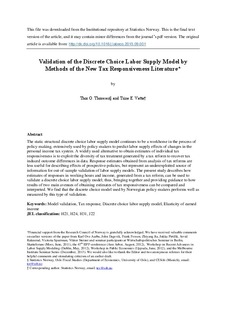| dc.contributor.author | Thoresen, Thor Olav | |
| dc.contributor.author | Vattø, Trine Engh | |
| dc.date.accessioned | 2016-09-08T13:36:28Z | |
| dc.date.available | 2016-09-08T13:36:28Z | |
| dc.date.issued | 2015-09-12 | |
| dc.identifier.citation | Thoresen, T. O. and T. E. Vattø (2015). "Validation of the discrete choice labor supply model by methods of the new tax responsiveness literature." Labour Economics 37: 38-53 | nb_NO |
| dc.identifier.uri | http://hdl.handle.net/11250/2405528 | |
| dc.description.abstract | The static structural discrete choice labor supply model continues to be a workhorse in the process of policy-making, extensively used by policy-makers to predict labor supply effects of changes in the personal income tax system. A widely used alternative to obtain estimates of individual tax responsiveness is to exploit the diversity of tax treatment generated by a tax reform to recover tax induced outcome differences in data. Response estimates obtained from analysis of tax reforms are less useful for describing effects of prospective policies, but represent an underexploited source of information for out-of-sample validation of labor supply models. The present study describes how estimates of responses in working hours and income, generated from a tax reform, can be used to validate a discrete choice labor supply model; thus, bringing together and providing guidance to how results of two main avenues of obtaining estimates of tax responsiveness can be compared and interpreted. We find that the discrete choice model used by Norwegian policy-makers performs well as measured by this type of validation. | nb_NO |
| dc.language.iso | eng | nb_NO |
| dc.publisher | Elsevier | nb_NO |
| dc.rights | Navngivelse-DelPåSammeVilkår 4.0 Internasjonal | * |
| dc.rights.uri | http://creativecommons.org/licenses/by-sa/4.0/deed.no | * |
| dc.subject | Model validation | nb_NO |
| dc.subject | Tax response | nb_NO |
| dc.subject | Discrete choice labor supply model | nb_NO |
| dc.subject | Elasticity of earned income | nb_NO |
| dc.title | Validation of the discrete choice labor supply model by methods of the new tax responsiveness literature | nb_NO |
| dc.type | Journal article | nb_NO |
| dc.rights.holder | © 2015 Elsevier B.V. All rights reserved. | nb_NO |
| dc.subject.nsi | VDP::Social science: 200::Economics: 210 | nb_NO |
| dc.source.pagenumber | Pages 38–53 | nb_NO |
| dc.source.volume | 37 | nb_NO |
| dc.source.journal | Labour Economics | nb_NO |
| dc.source.issue | December | nb_NO |
| dc.identifier.doi | http://dx.doi.org/10.1016/j.labeco.2015.09.001 | |
| cristin.fulltext | dc. type | Peer reviewed |

